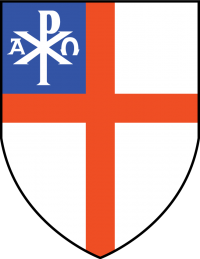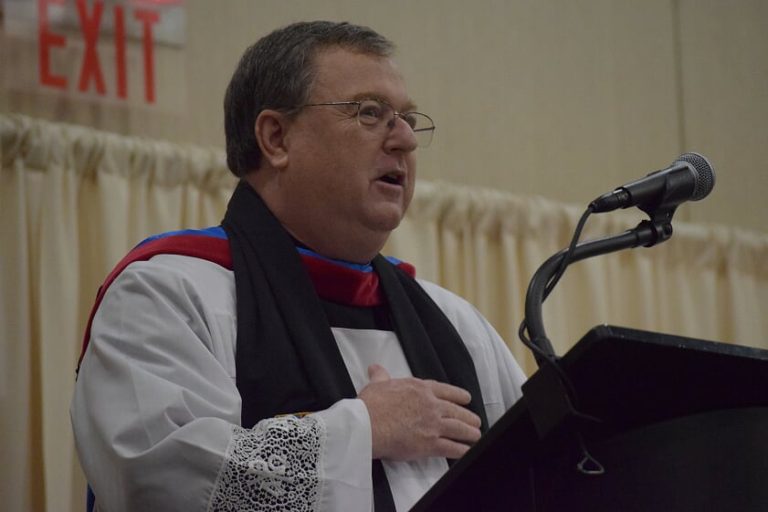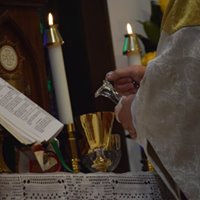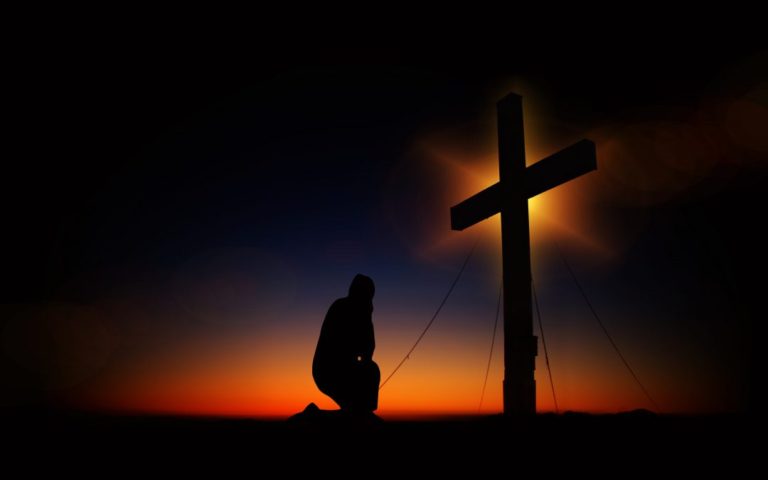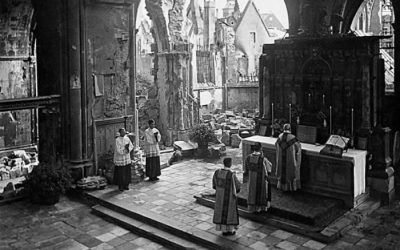Confirmation (Adult) Manual – 2019 Part 1 of 10
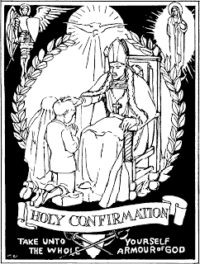
CHAPTER 1
Last edit 10-22-19
Introduction:
This Confirmation Manual is written in a conversational dialog which hopefully will make it readable and entertaining. We present the Anglican Faith in a manner showing its beauty; allowing the mystery of God to be accessible enough to touch and love while at the same time laying down guardrails for examining and meditating upon the beauty of His mysteries.
First of all, who are we? Well, I can answer for myself – I am a Christian who worships within the beauty of Anglicanism. Our denomination speaks of the way we worship and of our traditions which has to fall within the Historical Christian Church. So we are nothing new (some of us even feel old!) but we are grounded upon the “good ground” as spoken by Matthew, Mark, and Luke.
You will find as you read that we cover different important topics (ex: Sacraments & History) several times. This was done to reinforce and reveal at different depths, different topics as we try to peel back, layer by layer, some of the most interesting and difficult topics. It is hoped that this will allow a gradual absorption of these topics, as you will reflect upon them several times as we try not to just give a word “definition” but also a revelation as to what it means.
My desire is for this to be a fun “read.” I would love for it to be on coffee tables in of our homes, and as well, we are presenting this information on our website blog:
https://www.stmichaelsanglican.org/blog/
By doing this it can be pulled up on your phone as you wait hours for that delayed doctor’s appointment or that long delay at the airport. This is our original attempt, I am sure there will be many changes and updates and additions. Please join me on this journey of exploring the Christian Faith through the eyes of Anglican Worship.
Note: I used many sources for this endeavor, but the main outline used (the form in which the material is presented) was written originally in 1952 by the Episcopal Diocese of Alabama. It was interesting to see the light of Gospel highlighted in this work before being clouded by many changes of liberal modern thought and translations. As well, some my own work is incorporated to demonstrate the Beauty of Traditional Anglican Worship and the depth of Scripture revealed. Previous church “Confirmation Books” were also used as were books written by friends and parishioners. Therefore, this is mainly a collection of previous works which are combined for the edifying of the Anglican Faith.
A Catechism on the Sacrament of Holy Confirmation, (interesting information on the Sacrament of Confirmation)
By: The Right Reverend Chandler Holder Jones, SSC
What is the Sacrament of Holy Confirmation? Did Our Lord institute it?
The Sacrament of Confirmation is the Sacrament of Christian maturity, the Sacrament which properly completes Baptism, making us full members of Christ’s Church. It conveys to the baptised Christian the Seal of the Holy Ghost, the fulness of the Holy Spirit in His Sevenfold Gift: wisdom, understanding, counsel, spiritual strength, knowledge, true godliness, holy fear (reverence) (see Isaiah 11.2-3 and BCP 296-299). This Sevenfold Gift enables us to know and believe the true Faith, and strengthens our souls and wills to resist temptation and lead lives of virtue and holiness. Confirmation, as the Seal of the Spirit, enables us to bear the fruits of the Holy Spirit. It makes us full members, full participants, in the Royal Priestly Body of Christ, the Church; anointed with holy chrism (blessed oil) we are thus Anointed Ones, ‘little Christs’ in the Anointed One Himself, the Christ, Jesus— enabled fully to share in the Perfect Sacrifice of Christ, which is the Holy Eucharist (Saint Cyril of Jerusalem). This Sacrament equips us with the fulness of the Spirit’s Gifts in order to strengthen us to serve Christ faithfully as soldiers of Christ in the Militia Christi. We are therefore empowered by Confirmation bravely and boldly to proclaim the Faith of Christ Crucified and to live according to the Catholic Religion. The term ‘Confirmation’ means ‘strengthening’ from the Latin word confirmare, ‘to strengthen.’ The Holy Ghost is the Comforter, the Strengthener (Saint John 16). This Sacrament of Strengthening communicates to us the Seven Gifts of the Holy Ghost so that we may authentically live adult Christian lives of holiness, consecration, and commitment to the Gospel.
It is administered by the bishop, who lays his hands upon the candidate and invokes the Holy Ghost to come and strengthen the person with His Gift. Confirmation is an extension, a continuation, of Pentecost, the descent of the Holy Spirit. It is a baptised Christian’s ‘personal Pentecost;’ the same Messianic Spirit who descended upon Our Lord and the Apostles now descends upon the baptised person sacramentally, ensuring by promise the gift of Himself. The Sacrament of Confirmation is of Apostolic origin, administered by the holy Apostles according to the commandment and desire of Jesus Christ. Although Our Lord did not directly institute this Sacrament, He intended the Holy Ghost to be communicated to baptized Christians at the hands of the Apostles and their successors, the bishops of the historic episcopate in Apostolic Succession.
Confirmation has always been practiced in the Church from the beginning and must be received in order for baptismal grace to be completed and perfected in the Christian soul: ‘Now when the Apostles at Jerusalem heard that Samaria had received the word of God, they sent to them Peter and John, who came down and prayed for them that they might receive the Holy Spirit; for He had not yet fallen on any of them, but they had only been baptised in the Name of the Lord Jesus. Then they laid hands on them and they received the Holy Spirit’ (Acts 8.14-16). ‘…the Spirit was given through the Apostles’ hands…’ (Acts 8.18). ‘Then they were baptised in the Name of the Lord Jesus. And when Paul had laid his hands on them, the Holy Ghost came on them’ (Acts 9.1-2). ‘The doctrine of baptisms, and of the laying on of hands’ (Hebrews 6.1-2) was essential to the primitive Church. In the ancient and undivided Church, the three Sacraments of Christian Initiation, that is, the three mysteries which together brought a person into the full life and communion of the Church – Baptism, Confirmation, first Holy Communion – were administered together as one rite, one act of entrance into the Church.
Over the course of time, in the Western Church, Confirmation, the completion of Baptism, was separated from Baptism as the regular ordinary minister of Baptism became the parish priest: in the West, Confirmation retained its link with the bishop in Apostolic Succession as its true and rightful minister, in order that all baptised Christians should have sacramental contact with the bishop and receive the ‘touch of Apostolic Succession,’ a direct grace given by Christ through the Apostles. Confirmation, as the Seal of the Spirit, is, for many Christians, the once-in-a-lifetime gift from God received directly and only from the bishop as the Successor of the Apostles, the High-Priest of the Church, and the chief Shepherd of the flock of Christ.
The Anglican Church restricts the administration of Confirmation to the bishop alone; in the Roman and Eastern Churches, a priest may confirm with the anointing of chrism which is blessed by a bishop. Anglicans seek to preserve the most biblical, ancient and venerable tradition, that of episcopal Confirmation. In our Province, a bishop may confirm the candidate not only with the laying-on-of-hands, the original and apostolic matter or physical act in the Sacrament, but also with the anointing of chrism, scented oil blessed by the bishop. For this reason, Confirmation is also called ‘Chrismation,’ or Anointing, especially in the Churches of the East; it is the same Sacrament by whatever name.
Like Baptism, remember that Confirmation conveys an indelible spiritual mark on the soul, a sacramental character, which lasts forever and can never be repeated. Just as a person can receive the Spirit for the forgiveness of sins and regeneration in order to be born again only once, so a baptised Christian can only receive the fulness of the Holy Spirit once for eternity. Confirmation gives us a unique and special quality in that it makes us sharers in the Royal Priesthood of Christ, and it unites and conforms us to Christ the Anointed One in a unique way never to be removed, erased or repeated. It puts us into a relationship with Christ the Priest, and with the Holy Ghost, the Strengthener, which can never be re-established once achieved. We are confirmed only once.
Although we renew our baptismal vows in the liturgy of Confirmation in the Book of Common Prayer, such reaffirmation is technically not a part of the actual Sacrament of Confirmation. Yes, we should re-profess the vows which we made at our Baptism, or which were made for us as children, making them our own again, and we should reaffirm our faith in Jesus Christ, again renouncing the world, the flesh and the devil: Confirmation is the most crucial period in a Christian’s life in which this may be done. So, the Prayer Book provides for this to be done. It is an excellent idea, and, for most of us baptised as children, it is fundamental to our personal experience of professing and living the Christian Faith. But even so, the Sacrament does not directly depend on this very good and edifying practice; it is not necessary for the Sacrament to be valid. Confirmation is the ‘key and door to the Altar,’ making us eligible to receive the Most Blessed Body and Blood of Christ in the Holy Communion. Only those who have received this Sacrament, or who desire to receive it, may receive the Blessed Sacrament— this is because we are made full members of the Church only by Confirmation, full sharers in the Priesthood of the Body, and thus sharers in its One Sacrifice, the Holy Sacrifice of the Mass.
The Right Reverend Chandler Holder Jones, SSC
Important key members of the Anglican Church during the Reformation Period:
Initial introduction to THE CAROLINE DIVINES:
In the late 16th century and flowing through the 17th century was that period known as The English Renaissance. So many names spring quickly to mind beginning with Elizabeth I who appreciated the aesthetic. Associated with her are names like Spenser, Shakespeare, Sidney, Marlowe, Raleigh, Byrd and Tallis. The flowering did not stop with Elizabeth’s death, but continued through the reigns of James I and his son Charles I. So other names were added to the list: Gibbons, Bacon, Crashaw, Stone and Peacham to mention just a view. Not overshadowed by them were some divines like Donne, Herbert, Lancelot Andrewes, Cosin, Frank and Taylor whose sermons were among the best of literature written at this time. These and other divines who upheld the Catholic values of worship and doctrine came to be known as the Caroline Divines (some of these others include, Juxon, Sheldon, Hammond, Farindon, Gunning, Hacket, Curle, Duppa, Bramhall and Thorndike). T.S. Eliot, himself a fine poet and dramatist of the twentieth century, commenting on Andrewes’ sermons described them as ranking “with the finest English prose of their time”.
The English Church owes so much to these divines and especially to Andrewes as their mentor. T.S. Eliot described him as having “the voice of a man who has a formed visible Church behind him, who speaks with the old authority and the new culture. Andrewes is the first great preacher of the English Catholic Church.” Under their mentor they promoted the Catholic faith in the Reformed Church, and when persecuted for this during the Interregnum through deprivation and or in exile they patiently bore it for their Mother Church. Any suffering was considered worthwhile as it was but a taste of Christ’s sufferings at Calvary.
At what seems a crisis time in the Anglican Communion at the beginning of the third millennium, it would be good for many Anglicans to reflect on what the Caroline Divines’ legacy is to the English Church. I think the first thing they would insist on is obedience to the faith as handed down by the Fathers of the Church from Apostolic time and upheld by Holy Scripture, and certainly not anything that was modern.
The central doctrine of that faith was the Incarnation when the eternal Word took our flesh. This like the doctrine of the Trinity is one of the great mysteries of the Church. “That Heaven should thus come down to Earth, that God should become Man; that the Father of Eternity should be born in time”, never ceased to amaze Andrewes. The Incarnation for Andrewes and all Caroline Divines, as described by Dean Church at the end of the nineteenth century meant living in “adoration, self-surrender and blessing, and in awe and joy of welcoming the Presence of the Eternal Beauty, the Eternal Sanctity and the Eternal Love, the Sacrifice and Reconciliation of the world.” It was therefore as much a sensuous experience as spiritual, which further separated then from the Puritans who focused more on Christ as their “Captain”, leading them in the battle against sin and all evil in this world.
One aspect of the Incarnation that these Divines also emphasised was the kenosis. Like the early Fathers they were full of wonder that the Logos would be as Frank put it: “poorly born; in a stable amongst beasts; poorly wrapped in rags, poorly cradled in a manger, poorly bedded upon a lock of hay, poorly attended by the ox and ass, poorly every way provided for; not a fire to dress him at in the depth of winter, only the stream and breath of the beasts to keep him warm; cobwebs for his hangings, the dung of the beasts for his perfumes, noise and lowings, neighing and brayings, for his music; every thing as poor about him as want and necessity could make it.”
Closely associated with the Incarnation is the Sacrament of the altar. As Andrewes preached at Christmas 1618, the Child in the cratch will lead us to Him in the Sacrament, which outwardly like the cratch seems of little value but inwardly what treasure. “Of the sacrament we may well say Hoc erit signum,” but through the sign, “invenietis Puerum ye shall find this Child”. For finding His flesh and blood, you cannot miss but find Him too.” Thus by “infirma et egena elementa” we find Christ just as the shepherds “did this day, “in the beasts’ crib the food of angels; which very food our signs both represent and present unto us.” Christmas 1612 saw Andrewes preaching, “And this day they first came together, the Word and flesh; therefore, of all days, this day they would not be parted.” Two years later he concluded his Nativity sermon with this commendation. “This then I commend to you, even the being with Him in the Sacrament of His Body – that Body that was conceived and born, as for the other ends so for this specially, to be ‘with you’; and this day, as for other intents, so even for this, for the Holy Eucharist.” Taylor defined this succinctly when he stated that the Crib is the “altar where first lay that ‘Lamb of God’ which was afterwards sacrificed for the sin of all the world”
The celebration of the Eucharist for the Caroline Divines was the focus for all worship as it had been in the early Church, and they agreed with those early Fathers that it should be celebrated frequently. Those of us who attend daily Mass know how very special this is and know exactly what Andrewes meant when he stated that never are we as close to Christ as when we receive Him at the altar. Then we are almost angelic. He and all Caroline Divines knew in the phrasing of Augustine, unless we eat the Body of Christ we cannot be the Body of Christ in this world.
So it is not surprising that it dominated their preaching and teaching. “The chief point is that in the Sacrament Christ himself is received.” It is our perpetual Bethlehem, the manna from heaven, and at the end of life the viaticum as the soul journeys onwards. At the altar is our mystical union with our beloved Lord.
The Caroline Divines focused on:
WORSHIP THE LORD IN THE BEAUTY OF HOLINESS, TEACH THE FAITH OF THE FATHERS, UPHOLD THE DOCTRINE’S OF THE FIRST FOUR ECUMENICAL COUNCILS, GIVE DUE HONOUR TO MARY THE MOTHER OF GOD AND ALL THE SAINTS, RECEIVE THE BODY AND BLOOD OF CHRIST OFTEN
Nature of Anglicanism – AN INTRODUCTION & General Overview
Anglicans like most Christians everywhere, follow Jesus Christ, confess the faith of Christ crucified, proclaim his resurrection, and share in his eternal priesthood (after the order of Melchizedek.) [i]
We are Christians who worship within the Anglican Tradition. The Anglican Church has its roots in the Church of England, together with churches in other nations around the world which share the Church of England heritage, and are part of what is called the Anglican Communion. Each national Church within this fellowship is independent of the others in matters of local governance and discipline, but share a common heritage. However; the shared and once shared common understanding of Christian tradition and worship has been put in disarray and has even disappeared as some have changed the historical traditions and teachings into something new.[ii]
Our Province, the Anglican Province in America (APA,) accepts the Holy Scriptures of the Old and New Testaments as “containing all things necessary to salvation,” and as being the rule and ultimate standard of truth and faith. The apocryphal books of the Old Testament – which appear in the ancient Greek translation of the Old Testament, but not in the Hebrew Bible – are used and read in our churches, but are not used as Roman Catholic and Eastern Orthodox Christians, to establish any doctrine. The Apostles’ Creed and the Nicene Creed, ancient summaries of the Christian faith coming to us from the time of the undivided Catholic Church, are received as sufficient statements of the Christian faith. The Apostles’ Creed, used in the Church’s daily worship, is especially associated with the profession of faith made by candidates for Holy Baptism. The Nicene Creed, recited during the Eucharist on feast days, proclaims the Trinitarian faith of Christians throughout the world and throughout the ages.
The sacraments ordained by our Lord Jesus Christ, Baptism and the Lord’s Supper, are considered essential to Christian life and worship within Anglican tradition. Holy Baptism can be administered at any age, and the sharing of the sacramental Body and Blood of Christ in the Holy Communion takes place within the service of the Holy Eucharist, which is the Church’s chief act of worship on Sundays and Holy Days. Other sacramental rites are recognized and used in our Church, but are not considered necessary for all persons in the same way that Baptism and the Eucharist are (these will be discussed later.) We consider all baptized persons to be members of Christ Church (as we will see when discussing Baptism Rites.)
Some Christians are called to the ordained ministries of bishops, priests, and deacons, to serve the Church by teaching, governing, celebrating the sacraments, providing pastoral care, and in servant ministry to the world. This threefold ministry preserves and continues the apostolic ministry empowered by Christ himself, and transmitted in unbroken succession from the time of the Apostles. It is the same ministry shared by the Roman Catholic Church and the Eastern Orthodox.
The Anglican Communion believes that all truth comes from God, and that new knowledge, if true, can only help our understanding of God, as we do not see conflict between “science” and “religion.” In the interpretation of Scripture, we believe that the eternal spiritual truths are present within Scripture as defined by the Church itself. The Church, under the guidance of the Holy Spirit, is the proper interpreter of Scripture, and this process continues from generation to generation.[iii]
Anglicans believe passionately that living a Christian faith must show itself in reaching out to others especially to those who in any way are disadvantaged or oppressed, sick, or in need.[iv] Matthew 25:40 …”Verily I say unto you, Inasmuch as ye have done it unto one of the least of these my brethren, ye have done it unto me. The civil rights movement is a recent example of such an issue within the United States.
The Anglican Communion possesses a deep and rich tradition of Christian spirituality and invites its members to grow in holiness within this tradition according to their individual spiritual personalities.[v] One can find as deep and rigorous a Christian discipline within Anglicanism, but not a “one size fits all” mentality. Among us, discipline is usually not imposed (but it is expected) and each person walks on their spiritual journey.[vi]
Finally, Anglicans seek to “worship the Lord in the beauty of holiness”. The liturgical worship using the Book of Common Prayer is enriched by architecture, art, music, and whatever things of beauty each local congregation may be able to supply. Beautiful and inspiring worship informs and empowers our service in the world, and that service, laid before the altar, deepens our worship. In all things: we seek to glorify God and to serve Jesus Christ by serving his people in the world. Love God, Love Neighbor.
CHURCH HISTORY:
Adult inquirers are likely to be familiar with the proposition that the Anglican way is a “via media” or middle way between Catholic and Protestant and the our church stems from the Church of England. Let us examine and build upon these understandings and enrich them. First, we will discuss the English heritage and Secondly on the American Church.
Our emphasis will be on what is distinctive about Anglicanism, not on what is held in common with all other Christians. The central lesson of both sessions is that the Anglican via media is not just merely a compromise, but a distinctive approach to living the Christian life. Throughout; the recurring themes are those of balancing competing claims and living in the tension between opposites: English and Catholic, Protestant and Catholic, community and individual.[vii]
Anglicanism comes in different flavors: Anglo-Catholic, Evangelical, Liberal, and Broad Church are some of the terms that have been applied to these different perspectives. These different perspectives are all contained within Anglicanism but all are mediated by and through common prayer. The first thematic principle for these classes is that for Anglicans prayer shapes belief: lex orandi, lex credenda (the law of praying is the law of believing.) Anglican prayer is common prayer. The Church for Anglicans is not held together by a common confessional statement or by the theology of a particular leader, but by community in worship according to a Book of Common Prayer “in a language understood of the people.”
This uniqueness of the Anglican Church is that we have no one leader (such as a Calvin or Luther) but that we follow the faith of the Early Church and Church Fathers. You could say – we have as our Church Leaders – the Church Fathers themselves.
In America, its distinctive emphasis is on incarnational theology, centered in the Christian belief that “the word was made flesh and dwelt among us.” This is expressed in the importance of the Sacraments in worship, but also in the Anglican view of nature as revelatory of God and in a positive understanding of the engagement of the Church in this world. Anglicans are not separatists seeking a community of the pure or the saved, but committed participants in the struggles of a messy world that God loves and works to save.
Also, Anglicans value history and historical continuity. Our theology emphasizes continuity with the teachings of the apostles, and our polity stresses the value of the historic episcopate as a symbol of that link down through the centuries. Anglicans do not regard the sixteenth century Protestant Reformation as the beginning of their Church, but see the Church of today as extending in a direct line back to Christ and His Apostles.
ENGLISH HERITAGE
The Ecclesia Anglicana (a medieval Latin Phrase meaning English Church – 1246): Before the Reformation –
General theme: English Christianity existed as a distinctive synthesis of Celtic and Roman patterns with important additions of Benedictine spirituality (Celtic roots of Christianity in the British Isles, Augustine of Canterbury and the Council of Whitby in 664 Easter would be observed according to the customs of Rome, Benedictine spirituality and monasticism 6th century, Ecclesia Anglicana before Henry VIII.) The English Reformation:. The Church in England was a distinct Ecclesia Anglicana long before the Reformation.
General themes: The English Reformation was largely a political matter, and distinct from the Continental Reformation of Lutheran or Calvinist – though affected by both. Elizabeth I was more important to the Anglican via media than Henry VIII. Challenged from both Roman Catholic and Puritan sides, the Church of England was held together by a common English Bible and Prayer Book, a common national pattern of worship and spirituality.
Henry VIII and the break with Rome:
King Henry King Henry VIII (1491-1547) ruled England for 36 years, presiding over sweeping changes that brought his nation into the Protestant Reformation. He famously married a series of six wives in his search for political alliance, marital bliss and a healthy male heir. His desire to annul his first marriage without papal approval led to the creation of a separate Church of England. Of his marriages, two ended in annulment, two in natural deaths and two with his wives’ beheadings for adultery and treason. His children Edward VI, Mary I, and Elizabeth I, would each take their turn as England’s monarch.
Henry VIII the second son of Henry VII, the first English ruler from the House of Tudor (monarchs who were of the Tudor family.) While his older brother Arthur was being prepared for the throne, Henry was steered toward a church career, with a broad education in theology, music, languages, poetry and sports. Arthur had been betrothed since age 2 to Catherine of Aragon, the daughter of the Spanish rulers Ferdinand and Isabella, and in November of 1501 the teenage couple were married. Months later, Arthur died of a sudden illness. Henry became next in line for the throne and in 1503 was betrothed to his brother’s widow.
Over the next 15 years, while Henry VIII fought three wars with France, Catherine bore him three sons and three daughters, all but one of whom died in infancy. The sole survivor was Mary (later Mary I), born in 1516. Henry VIII issued a book-length attack on Martin Luther’s church reforms that earned him the title “Defender of the Faith” from Pope Leo X.
By the 1520s, Henry VIII had become infatuated with Anne Boleyn, a young woman in his wife’s entourage. He began to worry that his marriage to Catherine had been cursed by God because of the Old Testament ban on marrying the widow of one’s brother (Leviticus 20:21.) With the backing of the English parliament and clergy, Henry ultimately decided that he didn’t need the pope’s permission to rule on issues affecting the Church of England. In 1533 Henry VIII and Anne Boleyn were married, and their daughter Elizabeth was born. Mary (later Mary I) was declared illegitimate and Elizabeth named his heir. England’s monasteries were closed, and in most cases sold off, adding to Henry’s wealth. In 1538 an order was given to place an English Bible in every church.
After more marriages and more deaths, Henry VIII died on his 56th birthday, January 28, 1547. His 9-year-old son Edward VI succeeded him as king but died six years later. Mary I spent her five-year reign steering England back into the Catholic fold, but Elizabeth I, the longest-reigning of the Tudor monarchs, re-entrenched her father’s religious reforms.
Some believe that Henry VIII began the Church of England and while it is impossible to say an “exact date” we know that there was a presence of British Bishops at the Council of Arles in 314 A.D. and this shows evidence that there was an established church in England during that time, also there is additional testimony of an early date.[viii]
Thomas Cranmer and The Book of Common Prayer, 1549
Thomas Cranmer: (1489-1556) was consecrated Abp. of Canterbury in 1533 and was King Henry’s chief instrument in overthrowing the Papal supremacy in England. He annulled Catherine’s marriage to Henry and three years later pronounced a similar judgment on the King’s marriage with Anne Boleyn. He also married Henry to and divorced him from Anne of Cleves. He was partly responsible for the Ten Articles and the dissemination of the Bible in the vernacular. He was burnt at the stake in Oxford on 21 March 1556. The Church of England has much to owe to Cranmer – especially the masterly English style of its liturgy.
The First Book of Common Prayer: Although a formal break with the Papacy came about during the time of Henry VIII, the Church of England continued to use liturgies in Latin throughout his reign, just as it always had. However, once Henry died and the young Edward VI attained the throne in 1547, the stage was set for some very significant changes in the religious life of the country. And so a consultation of bishops met and produced the first Book of Common Prayer. It is generally assumed that this book is largely the work of Archbishop Thomas Cranmer, but, as no records of the development of the prayer book exist, this cannot be definitively determined.
The 1549 Book of Common Prayer was not created in a vacuum, but derives from several sources. First and foremost was the Sarum Rite, or the Latin liturgy developed in Salisbury in the thirteenth century, and widely used in England. Two other influences were a reformed Roman Breviary of the Spanish Cardinal Quiñones, and a book on doctrine and liturgy by Hermann von Wied, Archbishop of Cologne. This prayer book was in use only for three years, until the extensive revision of 1552 (Mary became in 1553 and restored Roman Catholic worship.) Much of the tradition and language of 1552 remains in the prayer books of today; however, some minor adjustments were added by King James in 1604. Much of the 1552 may be seen by even a cursory examination of the text.
1662 Book of Common Prayer: The new Preface written by Bishop Sanderson spoke of the struggle of the times, of the need to “keep the mean”, “moderation”. Three aims are stated. One, to preserve peace and unity in the church. Two, to promote piety and devotion. Three, to restrict the quarrelsome, those who would promote their own form. The book had a new calendar and rubrics and it utilized the 1611 Authorized Version of the Bible (King James Bible.) It added Prayers for those at Sea which was a puritan initiative which reflects the desire to address the “struggle of the times” as both sides had victories in the new work. The 1662 Book of Common Prayer is a permanent feature of the Church of England’s worship.
(Applicable End Notes – Please read as it contains vital information!!)
[i] The Christian faith, as explained by Lancelot Andrewes, is “one cannon given of God, two testaments, three symbols (Apostles’, Athanasian, and Nicene creeds), the four first councils of Nicaea I: 325; Constantinople I: 381; Ephesus: 431; Chalcedon: 451, and first five centuries and the series of Fathers therein.”
[ii] During the 1960’s, 1970’s, 1980’s until the present, Episcopalians began to make unscriptural decisions and promote unscriptural positions. First, they changed the Prayer Book and thus they changed many of the prayers. Then changed, without the full communion support – basically “on their own” a two thousand year tradition as they ordained women as clergy. Just like the Early Church, some Episcopalians began to teach things that are contrary to the historical teachings of the Church. Some said that Jesus is not God or that He did not rise from the dead. Others endorsed positions that are contrary to Scripture (homosexuality and abortion.)
Many concerned Episcopalians began to gather in various US cities during the 1960’s and 1970’s. They felt threatened that they would not longer to pray under a valid Bishop and be given priest which were not of the male character of Christ and that their “priest” would begin to teach things that are not part of the Traditional Faith.
Several of these people decided that in order to protect the teaching and worship of the Church, they would ask Bishops from all over the world to provide them with bishops and priests of their own as they began to set up small churches. Just as the English under Henry VIII, they did not claim to set up a new church from scratch. They received Holy Orders from bishops who succeeded the Apostles, and they taught from the Bible using the Book of Common Prayer as their guide. God provided for His Church.
These brave Anglicans were pioneers and set an example for others around the world who felt their Anglican Heritage was being changed and/or discarded. They were called “Traditionalist” and “Continuers.” St. Michael’s is one of the churches. It is a parish of the Diocese of the Eastern United States, which is under the jurisdiction of the Anglican Province in America. History; The present structure of the Anglican Province of America (APA) was erected in 1998, constituted by the Diocese of the Eastern United States and the Missionary District of the West. In 2000, the Missionary District of the West became a Diocese in its own right and in the 2008, the Diocese of Mid-America was erected in the central U.S. from the non-geographical Diocese of St. Augustine, which had come into union with the APA in 2004. The history of the APA, however, stretches back to 1968 with the founding of the American Episcopal Church (AEC) in response to the heretical teachings of Episcopal Bishop James Pike, the Social Gospel Movement in the mainline Protestant churches, and the liturgical movement spawned by the dramatic liturgical revisions of Vatican II. Our Diocese of the Eastern United States is the same diocese first erected in the old AEC, the first of the modern so-called “Continuing Churches.”
In 2017, The Anglican Province of America signed a Letter of Unity with Anglican Catholic Church, the Anglican Church in America, and the Diocese of the Holy Cross.
[iii] Knowing this first, that no prophecy of scripture is of any private interpretation…but (by) holy men of God spake as they were moved by the Holy Ghost. [iii] 2 Peter 1:20-21.
[iv] “To make religion nothing but an auricular profession, a matter of ease, a mere sedentary thing, and ourselves merely passive in it; sit still, and hear a Sermon and two Anthems, and be saved, as if by the act of the choir, or of the preacher, we should so be, (for these by their acts,) and we do nothing ourselves, but sit and suffer, without so much as anything done by us, any effundan (pouring) on our parts at all; not so much as this, of calling on the Name of the Lord.”
Religion to Andrewes was not just something “inward” but “outward” as well. The visible church was something very real to Andrewes as it had represented the Church of Christ from its beginning, having continuity with apostolic times which had been visible throughout its history. Thus he would strive to establish the English Church upon the ground of scripture and the early church. Andrewes had a nostalgic longing for the days of Christian unity and had an understanding of the Protestant Movement within the Church of England as he wrote to Bellarmine, “The people of the reformed churches have suffered no shipwreck of the faith, they reject no creed of the old Church, they admit all.”
Having determined the Christian Faith by examining the Canonized Scripture, the early Church Fathers, and the first four ecumenical councils, he undertook the task of formalizing the patterns which he believed should prevail in the English Church. This meant that he must defend the English Church against the onslaught of Roman Catholicism, and he also must bring his defense against some of the Puritan tendencies within the Church itself. With the Puritans it could be argued that Andrewes had more of a problem with their form of government than with the essentials of religion. As there was order and structure in God’s Creation, Andrewes believed that structure and order were proper for Christ’s Church. As he observed the many changes that the Puritan’s brought to the structure of church government, which was different than the English Church, he viewed the changes as disorder and the undoing of the current church in England. This meant that he had to face the problem, as far as the English Church was concerned; of propagating the idea of the continuity of a Catholic early tradition in the Church despite the break occasioned by Henry and later Elizabeth, as he had to promote the idea of Catholicism that was episcopal, but not papal. At the same time Andrewes sought to reduce the Puritan tone of earlier Elizabethan Anglicanism. His desire was to take the historical legitimacy of both by taking the same road of the early Church.
[v] Roman charge from Cardinal Bellermine in his Responsio ad librum: Triplici nodo, triplex cuneus (1608) that a man cannot be called “Catholic” who rejects transubstantiation, the temporal claims of the papacy, and the invocation of saints. This charge opened the door for Andrewes to enter into the apologetic field in defense of the Church of England. In doing so, he continues a theme of walking a path which the early fathers of the church traveled. He sought no new doctrines or ways of worship as he responded:
“Much detriment has the catholic faith suffered at your (Church of Rome) hands; much filth has it contracted, much from which it is no disgrace to us that we revolt…This filth has lately, in some parts of the world, been washed off, and the form…originally possessed has been restored. To this faith we cling as reformed; not to your deformation of it. Our religion you miscall modern sectarian opinions. I tell you if they are modern, they are not ours; our appeal is to antiquity yea, even to the most extreme antiquity. We do not innovate; it may be we renovate what was customary with those same ancients, but with you has disappeared in novelties…Subjection to Rome, dependence on Rome this is the sum of your religion.”
He defended the church against Roman influence as well as the Puritan strain of worship within the Church. Condemning responses to the Roman Church, he referenced the past to determine the future; however, his attitude towards the Puritans was gentler:
“Andrewes had no liking for compulsion; he trusted mainly to the power of persuasion to win and control the unruly and excited spirits about him. In one of his sermons he draws a beautiful picture of the true prince who “leads” his people, and does not “drag” them…Our guiding must be mild and gentle…Laud represents another method, that of legal coercion…Andrewes was in favor of gentle and gradual…he trusted to the educational influence, which indeed was already very marked…more belief in human nature than Laud, and it was an evil day for the Church when his presence was withdrawn.”
In seeking to remain faithful to early church tradition, he followed a road already traveled within both testaments as he looked for direction. The words from the Old Testament would be a guide to him:
Hb 2:20, “The Lord is in his holy temple; let all the earth keep silence before him,” and Ps 96:9, “O worship the Lord in the beauty of holiness; let: fear before him, all the earth,” and of the New Testament Jn 4:23, “The hour cometh, and now is, when the true worshippers shall worship the Father in spirit and truth: for the Father seeketh such to worship him.”
[vi] Nicolas Lossky, Lancelot Andrewes the Preacher (1555-1626): The Origins of the Mystical Theology of the Church of England, (Oxford: Clarendon Press, 1991), 6. “But if, on the other hand, to make a theology means to make more and more truly one’s own, by experience, the mystery of the relationship of God to man that has been traditionally lived by the Church, then originality will consist not so much in innovation, as enabling a whole era to grasp the genuine essence of the Christian message. In fact, the more the theologian penetrates into the heart of the mystery, the more his teaching will be personal, and consequently original.
[vii] Example is the “real presence” doctrine of the Eucharist. The difference between Roman Catholic Church doctrine of transubstantiation and the “real presence” view of the Church of England. Andrewes believed transubstantiation could not be an expression of faith, as it was a metaphysical explanation of how Christ was truly present within the Eucharist. He would write to Cardinal Bellarmine that English Christians believed no less than Roman Catholics that the Eucharistic presence was indeed real, but that they do not define the mode of that presence.
“Christ said “this is my body.” He did not say “this is my body in this way”. We are in agreement with you as to the end; the whole controversy is as to the method. As to the “This”, we hold with firm faith that it is. As to the “this is in this way”, (namely by the Transubstantiation of the bread into the body), as to the method whereby it happens that it is, by means of In or With or Under or By transition there is no word expressed [in Scripture]. And because there is no word, we rightly make it not of faith; we place it perhaps among the theories of the school, but not among the articles of the faith…We believe no less than you that the presence is real. Concerning the method of the presence, we define nothing rashly, and I add, we do not anxiously inquire, any more than how the blood of Christ washes us in Baptism, any more than how the human and divine natures are united in one Person in the Incarnation of Christ.”
[viii] Bede: Ecclesiastical History of the English People; P.51 – “In fertile Britain’s land was noble Alban born… Alban, yet a pagan (286AD) gave shelter to a Christian Priest fleeing from his pursuers. And when he observed this man’s unbroken activity of prayer and vigil, he was suddenly touched by the grace of God and began to follow the priest’s example of faith and devotion. … The priest lay hidden in Alban’s house … orders given to make a thorough search, and when they arrived at Alban’s house, holy Alban, wearing the priest’s long cloak, at once surrendered himself in the place of his guest and teacher, and was led bound before the judghttps://www.stmichaelsanglican.org/2019/03/22/confirmation-adult-manual-2019-volume-10-of-10/e.
